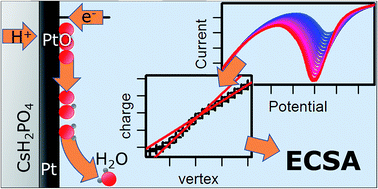In situ determination of the electrochemically active platinum surface area: key to improvement of solid acid fuel cells
Abstract
The electrochemically active surface area (ECSA) is an important parameter when investigating and developing electrodes for fuel cells. Various methods exist to determine the ECSA of polymer electrolyte membrane fuel cells both in and ex situ. However, for intermediate-temperature solid acid fuel cells (SAFC), a quantitative method to determine the ECSA has not yet been established. Here, we show that analysis of the electrochemical surface oxide reduction is a viable approach to quantify the ECSA in SAFCs. We validate the method using a Pt foil as model electrode and ex situ hydrogen underpotential deposition measurements. The applicability to SAFCs with composite powder electrodes is demonstrated in combination with an accelerated degradation test. The results reveal a surprisingly low decrease of the ECSA during operation of solid acid fuel cells. The method will enable a better understanding of novel nano-composite electrodes that are necessary for high performance devices.



 Please wait while we load your content...
Please wait while we load your content...